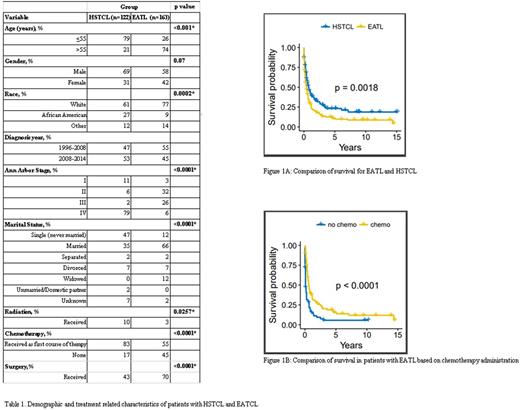Abstract
Introduction and Aim
Hepatosplenic T-cell lymphoma (HSTCL) and Enteropathy-associated T-cell Lymphoma (EATL) are rare aggressive peripheral T-cell lymphomas with dismal outcomes. Due to their rarity there is paucity of data on disease epidemiology and survival outcomes. We analyzed these rare diseases using Surveillance, Epidemiology and End Results (SEER) data to identify patient and disease factors that impact survival.
Methods
Using the SEER data, cases of HSTCL and EATL diagnosed between 1996 and 2014 were identified based on the ICD-O3 codes 9716 and 9717, respectively. Proportions were compared using chi-squared tests. Multivariable Cox proportional hazards models and stepwise regression were used to analyze disease-specific overall survival. Computations were performed in R.
Results
We identified 122 patients with HSTCL and 163 with EATL; both had male predominance with 69% in HSTCL and 58% in EATL (p=0.07). Median age was 38 years (range 4-83) in HSTCL and 64 years (range 23-96) in EATL patients. The HSTCL group was much younger with 79% aged <55 years compared to only 26% in the EATL group (P=<0.0001) (Table 1). Although both groups were primarily Caucasian - 61% in HSTCL and 77% in EATL, 27% of HSTCL patients were of African American race. While the majority of the HSTCL (53%) were diagnosed in 2008-2014, 55% of EATL pts were diagnosed in 1996-2008. Disease characteristics also differed between these entities with HSTCL mostly being advanced stage (81%) and EATL largely early stage (58%) at diagnosis; 79% of HSTCL patients had stage IV compared to only 31% in EATL (p<0.0001). Treatments in HSTCL pts included chemotherapy (83%) surgery (43%) radiation therapy (10%). On the contrary, surgery (70%) was the most common treatment in EATL followed by chemotherapy (55%) and radiation therapy (3%). Median OS for EATL and HSTCL were 9 (95% CI 715) and 5 months (95% CI 37), respectively (log-rank P= 0.0018 (Figure 1A). In univariate analysis, surgery (HR: 0.62, 95% CI: 0.39-0.96, p=0.032), and radiation therapy (HR: 0.3, 95% CI: 0.16-0.96, p=0.042) was associated with superior OS, while there was increased risk of mortality with advanced age (HR: 1.6, 95% CI: 1.01-2.79, p=0.043) in HSTCL patients. Sex, race, marital status, year of diagnosis, use of chemotherapy and stage failed to predict survival in HSTCL. However, in EATL advanced stage (HR: 1.48, 95% CI: 0.99-2.20, p=.052) was associated with inferior OS and use of chemotherapy (HR: 0.46, 95% CI: 0.31-0.67, p=.0001) was a positive predictor for OS. On stepwise regression analysis, surgery (HR 0.57; p=0.014) and radiation therapy (HR 0.33; p= 0.019) were associated with improved survival in patients with HSTCL, whereas in EATL patients receiving chemotherapy improved survival (HR 0.42; p<0.001) (Figure 1B) and advanced stage correlated with reduced survival (HR 1.60; p=0.01).
Conclusion
To our knowledge, this is the first and largest United States population based study of patients diagnosed with HSTCL and EATL. Our analysis showed that HSTCL is commonly diagnosed in younger, males with increased incidence in African American population compared to EATL. Although surgical interventions were commonly used in both entities, it was more frequent in EATL. While surgery and radiation improved survival in HSTL, chemotherapy was the significant factor in EATL.
No relevant conflicts of interest to declare.
Author notes
Asterisk with author names denotes non-ASH members.


This feature is available to Subscribers Only
Sign In or Create an Account Close Modal